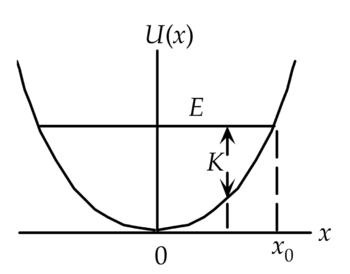(diff) ← Older revision | Latest revision (diff) | Newer revision → (diff)
Problem
Draw a potential energy diagram,  vs.
vs.  , and analyze
the motion of a mass
, and analyze
the motion of a mass  =5.0 kg resting on a frictionless horizontal table and connected to a horizontal spring with stiffness constant
=5.0 kg resting on a frictionless horizontal table and connected to a horizontal spring with stiffness constant  =160 N/m. Initially the mass is pulled a distance
=160 N/m. Initially the mass is pulled a distance  =1 m to the right from the equilibrium, and then the mass is released from rest.
=1 m to the right from the equilibrium, and then the mass is released from rest.
Determine
(a) the total energy of the system;
(b) the kinetic energy when  ;
;
(c) the maximum kinetic energy;
(d) the maximum speed and at what positions it occurs;
(e) the maximum acceleration and where it occurs.
Solution
The potential energy is given by

and so has a parabolic shape. The total energy of the object is

The object, when released, will gain kinetic energy and lose potential energy until it reaches  , where it will have its maximum kinetic energy and maximum speed. Then it continues to move to the left, losing kinetic energy and gaining potential energy, until it reaches its extreme point of
, where it will have its maximum kinetic energy and maximum speed. Then it continues to move to the left, losing kinetic energy and gaining potential energy, until it reaches its extreme point of  . Then the motion reverses, until the object reaches its original position. Then it will continue this oscillatory motion between
. Then the motion reverses, until the object reaches its original position. Then it will continue this oscillatory motion between  and
and  .
.
(a)
The total energy is

(b)
The kinetic energy is the total energy minus the potential energy

(c)
The maximum kinetic energy is the total energy 80 J
(d)
The maximum speed occurs at  , the equilibrium position at the center of the motion. Use the maximum kinetic energy (which is equal to the total energy) to find the maximum speed.
, the equilibrium position at the center of the motion. Use the maximum kinetic energy (which is equal to the total energy) to find the maximum speed.


(e)
The maximum acceleration occurs at the maximum displacement,  1.0 m, since
1.0 m, since




















